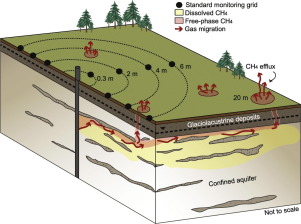Science of the Total Environment ( IF 9.8 ) Pub Date : 2018-10-16 , DOI: 10.1016/j.scitotenv.2018.10.217 O.N. Forde , K.U. Mayer , D. Hunkeler

|
Global methane (CH4) emissions are becoming increasingly important due to the contribution of CH4 to global warming. Leaking oil and gas wells can lead to subsurface CH4 gas migration (GM), which can cause both aquifer contamination and atmospheric emissions. Despite the need to identify and quantify GM at oil and gas well pads, effective and reliable monitoring techniques are lacking. In this field study, we used CH4 and carbon dioxide (CO2) efflux measurements together with soil gas stable carbon isotopic signatures to identify the occurrence and to characterize the spatio-temporal migration of fugitive gas across 17 selected well pads in Northeastern British Columbia, Canada. At 13 of these sites, operators had previously reported the occurrence of GM; however, subsequent inspections based on visual, olfactory or auditory evidence only identified GM at two of these sites. Using the soil gas efflux method, evidence for GM was found at 15 of the 17 well pads with CH4 and CO2 effluxes ranging from 0.017 to 180 μmol m−2 s−1(0.024 to 250 g CH4 m−2 d−1) and 0.50 to 32 μmol m−2 s−1 (1.9 to 122 g CO2 m−2 d−1), respectively. Stable carbon isotopic composition was assessed at 10 of the 17 well pads with 9 well pads showing evidence of GM. The isotopic values indicated that CH4 in soil gas was from the same origin as CH4 in the surface casing vent flow gas. There was no correlation between CH4 effluxes and the distance from the well head; an equal portion of elevated effluxes were detected >10 m from the well head as were detected <5 m from the well head. In addition, CH4 effluxes varied temporally with values changing by up to an order of magnitude over 2 h. Although the study was carried out in Northeastern British Columbia, the results are applicable on a global scale, suggesting that inspections mostly based on visual evidence (e.g. bubbling at the well head) are not reliable for the identification of GM and, that infrequent survey measurements at predefined locations close to the well head may overestimate, underestimate or even miss CH4 effluxes. Repetitive and relatively densely spaced gas efflux measurements using a dynamic closed chamber method proved to be a useful tool for detecting GM.
中文翻译:

井垫尺度上逃逸性气体迁移的识别,空间范围和分布
由于CH 4对全球变暖的贡献,全球甲烷(CH 4)排放变得越来越重要。油气井泄漏可能导致地下CH 4气体运移(GM),这可能导致含水层污染和大气排放。尽管需要识别和量化油气井垫上的转基因生物,但仍缺乏有效和可靠的监测技术。在此现场研究中,我们使用了CH 4和二氧化碳(CO 2)外流测量以及土壤气体稳定的碳同位素特征,以识别发生并表征逃逸气体在加拿大东北不列颠哥伦比亚省东北部17个选定的井垫上的时空迁移。在这些地点中的13个地点,经营者先前曾报告过转基因的发生。然而,基于视觉,嗅觉或听觉证据的后续检查仅在其中两个地点发现了转基因。使用土壤气体流出的方法,转基因证据被发现的17个孔焊盘15用CH 4和CO 2释放研究范围从0.017至180微摩尔米-2 小号-1(0.024至250g CH 4 米-2 d - 1)和0.50至32μmolm -2 分别为s -1(1.9至122 g CO 2 m -2 d -1)。在17个井板中的10个中评估了稳定的碳同位素组成,其中9个井板显示出GM的证据。同位素值表明,CH 4土壤气体中是从相同的来源CH 4的表面壳体通气口流量气体英寸 CH 4流出量与到井口的距离之间没有相关性。在距井口> 10 m处检测到等量的流出量与从井口<5 m处检测到的量相等。此外,CH 4流出量随时间变化,其值在2小时内变化高达一个数量级。尽管该研究是在不列颠哥伦比亚省东北部进行的,但该结果可在全球范围内使用,这表明,主要基于视觉证据(例如井口冒泡)的检查对于识别GM并不可靠,并且不经常进行测量在靠近井口的预定位置处,可能会高估,低估甚至错过CH 4的流量。使用动态密闭腔室方法进行的重复且相对密集的气体外排量测量被证明是检测GM的有用工具。



























 京公网安备 11010802027423号
京公网安备 11010802027423号